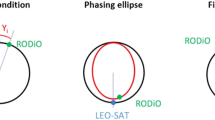Abstract
This paper introduces a strategy for an autonomous reconfiguration of a fractionated synthetic aperture radar (SAR) spacecraft system. The radar antenna is distributed on a small-satellite formation that can be reconfigured on orbit depending on the mission requirements. Once the acquisition geometry is specified in terms of formation type and the desired requirements are defined, the information is transmitted to the cluster. Hence, each satellite determines its own final state and elaborates the necessary trajectory for maneuvering. The reconfiguration algorithm is decentralized and exists in a distributed computational architecture. Therefore, the spacecraft platforms are assumed to be equal and able to communicate among each other. To demonstrate the viability of the proposed approach, a specific scenario is considered, with a distributed SAR operating at X-band that has to be reconfigured for interferometric applications. Simulation results show that once remote sensing requirements are specified, the developed algorithm can manage autonomously the spacecraft reconfiguration toward the corresponding operative pattern.









Similar content being viewed by others
Notes
Orbit eccentricities are of the order of \({10}^{-3}\) for remote sensing applications. Therefore products containing \(e\) are neglected in Eq. (3) since they can be considered as second-order infinitesimals.
Simulations are run on a 64-bit Windows 10 operating system, which is provided with an Intel® Core™ i7-7500U CPU at 2.70 GHz and a RAM of 8.00 GB.
References
Damico, S., Ardaens, J.S., De Florio, S.: Autonomous formation flying based on GPS - PRISMA flight results. Acta Astronaut. (2013). https://doi.org/10.1016/j.actaastro.2012.04.033
Kirschner, M., Montenbruck, O., Bettadpur, S.: Flight Dynamics Aspects of the GRACE Formation Flying. In: Proceedings of the 2nd International Workshop on Satellite Constellations and Formation Flying (2001)
Krieger, G., Moreira, A., Fiedler, H., Hajnsek, I., Werner, M., Younis, M., Zink, M.: TanDEM-X: A satellite formation for high-resolution SAR interferometry. IEEE Trans. Geosci. Remote Sens. 45, 3317–3340 (2007)
Bandyopadhyay, S., Subramanian, G.P., Foust, R., Morgan, D., Chung, S.J., Hadaegh, F.Y.: A review of impending small satellite formation flying missions. In: 53rd AIAA Aerospace Sciences Meeting (2015)
Carrer, L., Gerekos, C., Bovolo, F., Bruzzone, L.: Distributed radar sounder: a novel concept for subsurface investigations using sensors in formation flight. IEEE Trans. Geosci. Remote Sens. (2019). https://doi.org/10.1109/TGRS.2019.2929422
Sugihara El Maghraby, A.K., Grubisic, A., Colombo, C., Tatnall, A.: A novel interferometric microwave radiometer concept using satellite formation flight for geostationary atmospheric sounding. IEEE Trans. Geosci. Remote Sens. (2018). https://doi.org/10.1109/TGRS.2018.2800534
Felicetti, L., Palmerini, G.B.: Evaluation of control strategies for spacecraft electrostatic formation keeping. In: IEEE Aerospace Conference Proceedings (2014)
Yang, H., Yang, X., Zhang, W.: A co-operative control method for spacecraft formation configuration maintenance. In: 2014 IEEE Chinese Guidance, Navigation and Control Conference, CGNCC 2014 (2015)
Chu, J., Guo, J., Gill, E.K.A.: Long-term passive distance-bounded relative motion in the presence of J2perturbations. Celest. Mech. Dyn. Astron. (2015). https://doi.org/10.1007/s10569-015-9603-x
Huang, X., Yan, Y., Zhou, Y.: Analytical solutions to optimal underactuated spacecraft formation reconfiguration. Adv. Sp. Res. (2015). https://doi.org/10.1016/j.asr.2015.09.004
Chu, J., Guo, J., Gill, E.: Decentralized autonomous planning of cluster reconfiguration for fractionated spacecraft. Acta Astronaut. (2016). https://doi.org/10.1016/j.actaastro.2015.12.045
Zheng, Z., Guo, J., Gill, E.: Swarm satellite mission scheduling and planning using Hybrid Dynamic Mutation Genetic Algorithm. Acta Astronaut. (2017). https://doi.org/10.1016/j.actaastro.2017.04.027
Zheng, Z., Guo, J., Gill, E.: Onboard autonomous mission re-planning for multi-satellite system. Acta Astronaut. (2018). https://doi.org/10.1016/j.actaastro.2018.01.017
Yang, G., Yang, Q., Kapila, V., Palmer, D., Vaidyanathan, R.: Fuel optimal manoeuvres for multiple spacecraft formation reconfiguration using multi-agent optimization. Int. J. Robust Nonlinear Control (2002). https://doi.org/10.1002/rnc.684
Morgan, D., Subramanian, G.P., Chung, S.J., Hadaegh, F.Y.: Swarm assignment and trajectory optimization using variable-swarm, distributed auction assignment and sequential convex programming. Int. J. Rob. Res. (2016). https://doi.org/10.1177/0278364916632065
Sarno, S., Guo, J., D’Errico, M., Gill, E.: A guidance approach to satellite formation reconfiguration based on convex optimization and genetic algorithms. Adv. Sp. Res. 65, 2003–2017 (2020). https://doi.org/10.1016/j.asr.2020.01.033
Schlotfeldt, B., Thakur, Di, Atanasov, N., Kumar, V., Pappas, G.J.: Anytime planning for decentralized multirobot active information gathering. IEEE Robot. Autom. Lett (2018). https://doi.org/10.1109/LRA.2018.2794608
Grant, M., Boyd, S., Ye, Y.: CVX: Matlab software for disciplined convex programming (web page and software). http://cvxr.com/cvx
Chapin, E., Chen, C.W.: Along-track interferometry for ground moving target indication. IEEE Aerosp. Electr. Syst. Mag. 23, 19 (2008)
D’Errico, M., Fasano, G.: Relative trajectory design. In: D’Errico, M. (ed.) Distributed space missions for earth system monitoring, pp. 125–162. Springer, New York (2013)
López-Dekker, P., Krieger, G., Moreira, A.: Multistatic radar systems. In: D’Errico, M. (ed.) Distributed space missions for earth system monitoring, pp. 61–122. Springer, New York (2013)
Boyd, S., Vandenberghe, L.: Convex optimization. Cambridge University Press (2004)
Betts, J.T.: Practical methods for optimal control and estimation using nonlinear programming. In: Advances in design and control SIAM (2010). https://doi.org/10.1137/1.9780898718577
Author information
Authors and Affiliations
Corresponding author
Additional information
Publisher's Note
Springer Nature remains neutral with regard to jurisdictional claims in published maps and institutional affiliations.
Rights and permissions
About this article
Cite this article
Sarno, S., D’Errico, M., Guo, J. et al. Autonomous reconfiguration of a distributed synthetic aperture radar driven by mission requirements. CEAS Space J 12, 527–537 (2020). https://doi.org/10.1007/s12567-020-00320-w
Received:
Revised:
Accepted:
Published:
Issue Date:
DOI: https://doi.org/10.1007/s12567-020-00320-w




